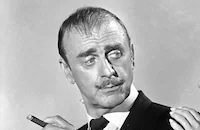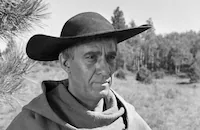Based on a television play by Gore Vidal, it offers a fresh approach to the life and legend of William "Billy the Kid" Bonney, treating him as a deeply troubled youth rather than a bloodthirsty desperado. When cattle rancher (Colin Keith-Johnston), who has become a father figure for Billy, is murdered, the awkward, illiterate and impulsive Billy plots a reckless vengeance with the help of two impressionable friends (James Best and James Congdon). Pat Garrett (John Dehner), Billy's friend and protector, tries to coax the young gun into a more peaceful life but when Billy's single-minded crusade threatens the well being of the community, Garrett must take up arms against the spirited youth. Trailing behind the unstable young gunman is a writer from back East (Hurd Hatfield), whose published tales inflate the exploits of William Bonney to mythic status. And so the legend of Billy the Kid is born; but Booney is unable to live up to his famous name, thus questioning the historical verity of the myth-laden Wild West (a device later borrowed in Clint Eastwood's Unforgiven (1992).
On the surface, The Left-Handed Gun appears to be a traditional Western, but its cowboy-movie trappings are split apart by Newman's unorthodox performance. Fresh from his Actor's Studio training, Newman (who starred in the original 1955 television version) defies convention by mumbling, flaring up and contorting himself in poses of internal anguish. Fellow Method actor James Dean had expressed interest in playing Billy the Kid, and one can almost see his seething, actorly angst reflected in Newman's tormented performance.
Some critics derided Newman's portrayal of Billy the Kid (The New York Times wrote that he, "seems to be auditioning alternately for the Moscow Art Players and the Grand Ole Opry") but the film found greater critical success in Europe, where cinematic rule-breaking was more graciously received.
In hindsight, The Left-Handed Gun was more significant than even the French realized, laying the groundwork for the revisionist Western, a movement that would reach fruition a full decade later. It wasn't until the late 1960s and early '70s that audiences began to accept these stylized films that revisited - and some might say eviscerated - the traditional Western as a means of revealing bitter truths about American history: films such as Sam Peckinpah's The Wild Bunch (1969), Robert Altman's McCabe and Mrs. Miller (1971) and Penn's Little Big Man (1970).
Penn frequently used historical films as the foundation for social commentary, and one could view The Left-Handed Gun as a practice run for Penn's revisionist gangster film Bonnie and Clyde (1967), which continues to influence filmmakers today.
While its unconventionality is often distracting, The Left-Handed Gun marked Penn as a director of great potential, whose promise was fulfilled over the next several decades. As Paul Newman recalled, "I knew he was good... it was evident that he'd really make it."
Director: Arthur Penn
Producer: Fred Coe
Screenplay: Leslie Stevens
Based on the Teleplay The Death of Billy the Kid by Gore Vidal
Cinematography: J. Peverell Marley
Production Design: Art Loel
Music: Alexander Courage
Cast: Paul Newman (William Bonney), John Dehner (Pat Garrett), Hurd Hatfield (Moultrie), James Best (Tom Folliard), James Congdon (Charlie Boudre), Colin Keith-Johnston (Tunstall), Lita Milan (Celsa).
BW-103m.
by Bret Wood



























